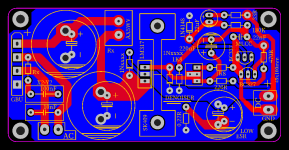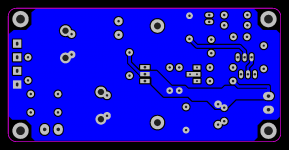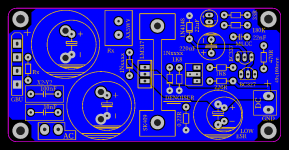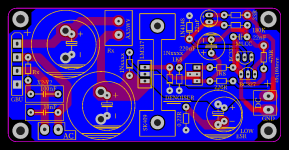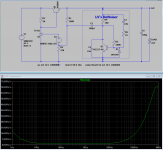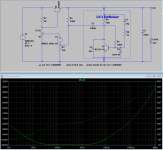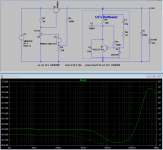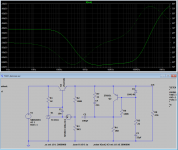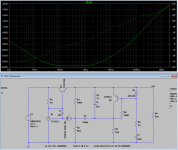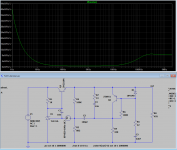I think the regs power pins 8, 20, and 29
None of them is high current?
I also prepared a pcb for my own needs. It is similar to tombo56's project.
Attachments
Please make sure - as a feedback loop likes to be as short as possible - that R1 (= 220 ohm) is placed as close to the pins of the LM3xx as possible, preferably on the pins at the bottom.
This is not necessary and critical at all. Anyway, additional feedback loop goes from output connector through denoiser circuit and Kelvin connection. I am no authority and you doesn’t have to believe me, but ask yourself why on Mark Johnson’s VRDN design those resistors are not especially close to the LM regulator output pin.
I also prepared a pcb for my own needs. It is similar to tombo56's project.
Gerbers & .pdf file.
Attachments
I have a bunch of the LR8N3 HV regulators -- will only dissipate 0.75W (the TO-252 package will do 2.5W). Very handy as a high voltage current source, but no champ when it comes to noise.
This regulates, but I have yet to test it for noise, PSRR and Z-out. The first version I built oscillated at 61MHz! There is only a faint trace of oscillation in this version:
Hi jackinnj
Are you test it again. High voltage regulator with low noise will be a good new.
Good luck
Has it been tried to use a de noiser over a TL431 based regulator ?
Instead of a LM317 one can build a series regulator with a transistor and a TL431 as a zener diode. A well known application of TL431, in the datasheet.
What about adding a simple denozier ( the one using one transistor ) ?
Can one expect, results as good as with LM317 ?
Instead of a LM317 one can build a series regulator with a transistor and a TL431 as a zener diode. A well known application of TL431, in the datasheet.
What about adding a simple denozier ( the one using one transistor ) ?
Can one expect, results as good as with LM317 ?
I don’t expect that anybody has actually used denoiser with the TL431.
According to LTSpice simulation, results could be even better than with LM regulators. There is a 60 dB improvement. That’s probably as TL431 reference pin can be driven with uA current so high R values can be used in voltage divider, providing easy load on the denoiser circuit.
Noise density is 1,38 nV/√Hz.
This simulation is not actual circuit to build, just test case to see does it behave and indeed it does.
I see possibility of fine adjustable low noise voltage reference if some temperature compensation is added.
According to LTSpice simulation, results could be even better than with LM regulators. There is a 60 dB improvement. That’s probably as TL431 reference pin can be driven with uA current so high R values can be used in voltage divider, providing easy load on the denoiser circuit.
Noise density is 1,38 nV/√Hz.
This simulation is not actual circuit to build, just test case to see does it behave and indeed it does.
I see possibility of fine adjustable low noise voltage reference if some temperature compensation is added.
Attachments
Which TL431 model are you using? Seems to be ill-behaving in transient analysis.This simulation is not actual circuit to build, just test case to see does it behave and indeed it does.
I am very grateful for your work.I don’t expect that anybody has actually used denoiser with the TL431.
According to LTSpice simulation, results could be even better than with LM regulators. There is a 60 dB improvement. That’s probably as TL431 reference pin can be driven with uA current so high R values can be used in voltage divider, providing easy load on the denoiser circuit.
Noise density is 1,38 nV/√Hz.
This simulation is not actual circuit to build, just test case to see does it behave and indeed it does.
I see possibility of fine adjustable low noise voltage reference if some temperature compensation is added.
This is great news.
The original reason I got interested in a TL431 instead of LM317 is because I need a 32V output voltage, trouble is, with the transformer I use, the unregulated voltage can be too high for a LM317 at start up when the output capacitor has no charge. I know the usual solution is a zener across the transistor, but I don't like a powerful zener in case of a large cap. So the topology with a TL431 comes handy, thanks to it's 36V capability safely under the 32V output voltage.
Then I figured the noise and regulation would be pretty good and with Elvee D noizator could be great.
I am aware that the noise at the TL431 at near 32V is about 13 times more than on the datasheet giving noise for 2.5V.
I did not figure out this noise would result at the PSU output. With D noiser or not.
The transistor I will use is actually a CFP combo. With the emitter of the driver at the output side
I'm using this model which I assume is quite accurate:It is marked as TI model and I have 5 slightly different TL431 models. This is not proper implementation, just a test case. Where do you see a problem in the AC analysis results?
Accurate TL431 model development, analysis and evaluation | Audio Perfection
With this model TL431+denoiser oscillates in transient analysis.
I am still in a very poor condition but I feel the need to make an important remark: the phase of the corrector is wrong.I don’t expect that anybody has actually used denoiser with the TL431.
According to LTSpice simulation, results could be even better than with LM regulators. There is a 60 dB improvement. That’s probably as TL431 reference pin can be driven with uA current so high R values can be used in voltage divider, providing easy load on the denoiser circuit.
Noise density is 1,38 nV/√Hz.
This simulation is not actual circuit to build, just test case to see does it behave and indeed it does.
I see possibility of fine adjustable low noise voltage reference if some temperature compensation is added.
You need a PNP transistor, with its base tied to the GND.
If you simulate this version in the time-domain for a sufficient simulation time, you will see VLF oscillations
I wish you fast and full recovery from the bottom of my heart.
Is this pandemic related? I couldn't find anything about this on forum. I hope Elvee's condition is good.
I don’t think that it is pandemic related. Maybe you noticed that Elvee has disappeared from the forums after August 12th. Unfortunately, he was not on the vacation but in the hospital. I found this recently when he posted information in one other thread.
Anyway, we should not discuss someone’s health here, except for wishing him well and that he can soon return to things he enjoys the most.
Anyway, we should not discuss someone’s health here, except for wishing him well and that he can soon return to things he enjoys the most.
Last edited:
I'm using this model which I assume is quite accurate:
Thanks’ for the model tip. I will use that in the corrected simulation.
To return the favor, if you don’t already use this source there is a fantastic collection, with some elsewhere unavailable models and examples. I found this while looking for some optocoupler models:
For LTspice users. Libraries of models, examples, etc
I didn’t think even for a second about signal phasing, as quick job simulation was showing expected improvement (with unwanted and unspotted bonus – oscillation). That’s how it is when you are left with only several functional brain cells. 
Here is corrected one, using more accurate TL431 model. Results are still extraordinary: up to 125 dB PSRR and 0,7 nV/√Hz noise density at 32V output (less than 0,1 uV of total noise voltage).
Depending on the load current, this could be real circuit with replacing Q1 with Sziklai or Darlington.
Here is corrected one, using more accurate TL431 model. Results are still extraordinary: up to 125 dB PSRR and 0,7 nV/√Hz noise density at 32V output (less than 0,1 uV of total noise voltage).
Depending on the load current, this could be real circuit with replacing Q1 with Sziklai or Darlington.
Attachments
Last edited:
- Home
- Amplifiers
- Power Supplies
- D-Noizator: a magic active noise canceller to retrofit & upgrade any 317-based V.Reg.
